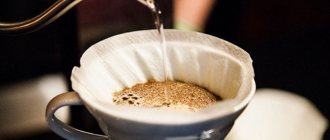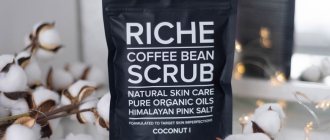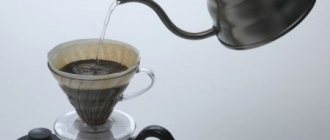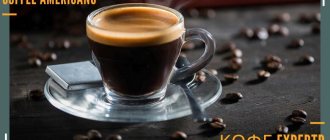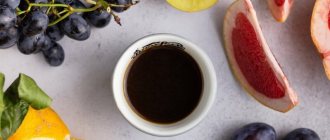The pace of modern life leaves less and less time to work magic on the Turk yourself. A variety of options for quickly preparing a natural drink has been replenished with coffee in individual use bags. Coffee in bags for brewing in a cup confidently claims to be a public favorite. How good is the noble drink in such packaging, who produces it, what are its pros and cons?
Types of bagged coffee
The idea of natural coffee in bags has been brewing for a long time and has taken shape in several versions.
- Single serving of finely ground coffee in a portion bag. This coffee needs to be poured from the bag into a cup and simply filled with water. We get natural coffee, but there are coffee grounds left in the cup, which are sometimes difficult to dispose of.
- Portioned coffee in closed filter bags with a thread holder. These bags are most similar to regular tea bags, only larger in size. They are placed in a cup and poured with boiling water, infused, and then removed.
- Coffee in specially designed bags. Its manufacturers took the path of improving packaging, which they called a drip pack, that is, a drip bag. It allows you to get a portion of natural coffee, well brewed, and at the same time, without any extraneous grounds in the cup. It is this version of portioned coffee that is gaining increasing popularity. Based on the name of the packaging, the drink was called drip coffee.
Drip coffee
Drip coffee is portioned coffee in a specially designed package that allows you to prepare a natural drink by pouring it and then removing the grounds from the cup. The name refers to the brewing method, not the type of coffee itself.
For packaging drip coffee, special multi-layer filter paper is used. It is made from natural cellulose, which is not subject to additional bleaching or other chemical influences. Therefore, contact of such paper with a drink is completely safe.
How it works?
Each serving of coffee is packed in foil. Cutting this package open, we see a square bag of filter paper. In the upper part there are folded elements made of thick cardboard. What actions should be taken next?
- Straighten the cardboard handles of the bag and pull them to the sides.
- The package will open to its full width. Coffee powder will be visible in it, and cardboard handles will stick out in different directions.
- Attach the handles to the cup, or rather, hook them to the opposite edges of the cup. The bag of coffee is locked open.
- Pour hot water into the coffee filter bag in a thin stream. Connoisseurs will see here an analogue with a pour-over, and this is indeed the case. Pour-over brewing technology inspired inventors to create coffee in bags.
When brewing drip coffee, the water must be poured slowly, without rushing. The approximate time for a 200 ml cup is at least a minute.
- Filled with hot water, the coffee must be left for 1-2 minutes.
- Then remove the cardboard handles of the bag from the edges of the cup, pull them and remove the bag of coffee grounds.
- The bag is no longer needed, it is disposed of, and you are left with a cup of hot, natural, strong coffee without any sediment.
This method gets its name from the English word drip, which means “drop”. The term rather refers to the method of preparing coffee, but it is already firmly attached to the packaging. Therefore, the name drip coffee can mean both a drink prepared by pouring and portioned coffee in specially designed bags.
Types of single-serve coffee
Coffee in disposable bags can be of any type. Most often, manufacturers use a mixture of different grains.
- The inscription on the packaging of 100% Arabica means that a mixture of grains from different countries and even continents was used as raw materials.
- If robusta was used in the production of raw materials, then the proportion must be set, for example - Arabica 80%, Robusta - 20%. The higher the Robusta content, the stronger the coffee.
- The term "blend" also means a mixture, but it can contain coffee beans from the same territory or variety. For example, Kilimanjaro blend is a blend of coffee collected on African farms of the Kilimanjaro volcano, and Mocha blend is a mixture of Arabica beans from Yemen.
- If the packaging indicates the variety - Nicaragua Maragogipe or Tanzania Peaberry - then the ground coffee belongs to the single-origin class.
- Coffee without notes on the origin of the beans for raw materials is made from a very different mixture of beans and is considered low-grade.
TOP best reusable filters for brewing drinks
Outwell 13778755
This holder belongs to the folding category and is designed for preparing coffee drinks. For production, high-quality food-grade silicone is used, which is not afraid of significant heat. The rim is made of steel. An excellent solution for travelers who cannot imagine a day without coffee. Can be folded if necessary. Doesn't take up much space. The composition is classified as safe. Stated dimensions: 130x30 mm. Made in China.
Average price – 2068 rub.
coffee filters Outwell 13778755
Advantages:
- quality of assembly and components;
- reusable products;
- stylish design;
- unlimited service life.
Flaws:
- not identified.
Tovolo 37158842
This compact and easy-to-use device is designed for brewing coffee, tea and herbal infusions. Stated dimensions: 70x65 mm. For manufacturing, a high-quality metal alloy is used, which is classified as safe. There are also plastic inserts. The material withstands significant temperature changes. Produced in the USA.
Cost – 1680 rub.
coffee filters Tovolo 37158842
Advantages:
- long service life;
- numerous positive reviews;
- quality of assembly and consumables;
- stylish appearance.
Flaws:
- not identified.
X Home 26990366
High quality ABS plastic is used to make this device. The material is classified as safe and is resistant to significant temperature changes. The design is designed for brewing coffee. To prepare the drink, it is recommended to use a container with a diameter of 76-110 mm. The surface is painted black. The delivery set includes one filter, which is classified as reusable. Produced in the Middle Kingdom.
How much does the product cost? The purchase will cost 1168 rubles.
coffee filters X Home 26990366
Advantages:
- stylish appearance;
- increased service life;
- absence of foreign aromas;
- time-tested manufacturer;
- safe composition.
Flaws:
- not identified.
Long Cam 26911357
This press filter is designed for preparing coffee drinks. For this you will need medium grind grains. The delivery set includes a press filter and instructions for its use. High quality stainless steel is used for production. The capacity factor is 460 ml. To prepare the drink you will need 3 teaspoons of crushed grains. Afterwards, a press is used, which does not require much effort to press. It turns clockwise. Boiling water is poured into the structure and covered with a lid. The cooking process will not take more than 4 minutes. If desired, you can add sugar, milk or cream. Declared dimensions: 115x170 mm. Produced in Vietnam.
Average price – 799 rubles.
coffee filters Long Cam 26911357
Advantages:
- equipment;
- numerous positive reviews;
- quality of assembly and components;
- unlimited service life;
- stylish design.
Flaws:
- not identified.
OSOKA 34918430
This model is made from high-quality ABS plastic and stainless steel. The reusable design is used for brewing coffee drinks. An indispensable item for travelers and lovers of this drink. The filter is installed on the surface of the drinking container. Ground coffee beans are placed inside and poured with boiling water. As a nice addition, there is a high-quality mesh made of stainless steel. Helps filter grain particles and prevent them from getting into the cup. For subsequent care, rinse the product under running water. Stated dimensions: 73x65 mm.
Cost – 700 rub.
coffee filters OSOKA 34918430
Advantages:
- reusable design;
- numerous positive reviews;
- build quality;
- ease of use and subsequent care.
Flaws:
- not identified.
Cost of coffee bags, where to buy, who produces
Coffee in drip bags
Its first producers were the Japanese. They were inspired by the pour-over method of brewing, popular in the Land of the Rising Sun. Other manufacturers borrowed the idea from the Japanese. In Russia, drip coffee is rapidly gaining popularity, and its own manufacturers are appearing.
- Coffee Yata . Several types of coffee are sold under this brand in filter bags. The assortment includes single-varietal varieties Cuba Turquino and Colombia Supremo, as well as blends from different parts of the world. The manufacturer of the brand is a Russian company. The cost of a package of 10 sachets of 8 grams is 250 rubles. That is, 100 grams of such coffee costs approximately 315 rubles, one serving costs 25 rubles.
- Blendy. It sells mainly blends of good Arabica coffee. The brand is of Japanese origin and is manufactured by the large concern AGF. The products are appreciated by domestic coffee lovers. The cost of a package of 8 sachets of 7 grams is 250 rubles. The cost of 100 grams of coffee is 445 rubles, and one cup is about 31 rubles.
- Brand . Another Russian manufacturer. He currently sells only one variety of coffee, Brazil Santos, at a cost of 350 rubles for 10 bags weighing 8 grams. 100 grams will cost 440 rubles, and one serving will cost 35 rubles.
- Coffesso . Trademark of the Russian manufacturer May. Sells Italian roasted Arabica beans. A package of 8 bags will cost from 230 rubles, that is, one serving – from 28 rubles.
Ground coffee in bags for one cup
Well-known brands are experimenting with such packaging, but, apparently, the format is not very popular.
- The Madeo brand offers individual servings for one cup at prices ranging from 320 to 550 rubles per pack of 10 pieces, which gives the cost per serving from 32 to 55 rubles.
- Lavazzo , a well-known European brand, some time ago also made an attempt to produce natural coffee for one cup. The cost was about 400 rubles for 10 sachets, but recently offers of this product have disappeared even from specialized stores.
Coffee in closed filter bags
They are produced by little-known and completely unknown manufacturers in our country, which, frankly speaking, do not inspire much confidence.
- Bestcoffee from Latvia offers bags at a price of 300 rubles per pack of 10 pieces. The origin of the grains is not specified. One bag contains 8 grams of ground powder.
- PHUONG Vy is a Vietnamese brand. Offers 100% Arabica under the name "Superb Morning". A package of 16 sachets costs 295 rubles. Brewing takes place for 3-5 minutes in hot water.
Even the mentioned manufacturers are difficult to find on supermarket shelves; they sell their products mainly through online stores.
It seems that drip coffee is winning the competitive race for now. It is preferred by manufacturers, buyers, and retail chains.
How they appeared
They first learned about such an invention at the end of the last century. The development of the process took place in several countries at once.
Japan
The Japanese company Yamanaka & Co in 1990 released small bags made of microfiber, which were filled with ground roasted coffee beans. The products were attached to the top of the mug using several hooks.
In 1990, OHKI slightly changed the packaging, equipping it with handles that rest in opposite directions. This made the structure more stable and the drink itself more popular.
USA
In the states, this option has been popularized only since 2010. In 2015, American companies began to independently produce coffee in filtration drip bags. At the moment, this brewing option is one of the most popular in the country. Moreover, the increase in popularity is noted every year.
Russia
Drip packages captured the Russian market back in the early 2000s. In 2014, sales figures increased so much that they launched their own production in Russia (the Coffesso brand took over this).
At the moment, there are quite a few manufacturers of coffee in filter bags, and the popularity of drinks is only growing.
Drip packages
Pros and cons of different types of coffee bags
What are the main pros and cons of coffee in different types of individual packaging.
Drip coffee
pros
- Ease of use.
- Efficiency of preparation. The process takes 2 minutes.
- No coffee grounds in the cup.
- Good quality natural drink.
- Mobility of drip packages. They can be used anywhere there is hot water.
- Compact packaging of each serving. You can take it with you or purchase the exact number of servings.
Minuses
- The cost of one serving is significantly higher than a cup of natural coffee brewed in the usual way. Coffee in drip packs costs from 25 to 35 rubles per serving. If you make coffee in a Turkish coffee pot or simply pour boiling water over coffee powder in a cup, the cost of a serving of a very decent quality drink ranges from 5 to 10 rubles. It turns out that drip technology increases the cost of a cup by 2.5-7 times.
- The need to control the brewing process. Filling the cup with hot water too quickly is not recommended. You need to pour the water quite slowly, then the coffee will release all its taste and aroma.
- There is still a small range of drip coffee in stores.
Individually packaged portioned ground coffee
pros
- Compact packaging
- Good quality drink
- Mobility of use
- Easy to prepare.
Minuses
- Presence of grounds in the drink
- The high price of a serving is from 30 rubles, which is 3-6 times higher than the exact same serving of coffee, but poured into a cup from a large bag, and even surpasses some types of drip coffee.
- Difficulty in purchasing. Individually packaged coffee is difficult to buy even in large supermarkets and its range is limited.
Portioned ground coffee in closed filter bags
pros
- Ease of use
- No grounds in the cup.
- Compact movement and storage
Minuses
- Low quality drink. This fact is noted by all users of this technology.
- High cost, comparable to the price of drip packages.
- Cooking duration. It will take twice as long to get a portion of the drink than a cup of drip coffee.
- Low level of distribution, difficult to find even in online trading.
Scope of use of filter packages
Tea and coffee are drinks that are especially popular all over the world. They are healthy, tasty, invigorating and aromatic. They allow you to quench your thirst and warm up, wake up and recharge with positive energy, lift your spirits and tune in to the positive.
However, many are faced with a banal problem - the inconvenience of brewing. The best manufacturers have come to the rescue, trying to make life easier for their fans and make their lives comfortable and happy. For this purpose, the production of special filters with the function of brewing coffee, herbal infusions, and tea has been launched.
The main advantages of the devices include:
- no need to use a strainer;
- no need to catch large particles of coffee or leaves;
- brewing speed;
- simplicity of the manipulations;
- affordable pricing policy;
- reusable.
Where to buy the products is not a question. It is sold in all specialized retail outlets. You can order goods online in the online store. It should be noted that the kit may contain a different number of accessories. Their final cost depends on this. Silicone or wooden devices can be purchased individually.
Application area
Every year, manufacturers delight consumers with improved new products. Which company is better to purchase a set depends on personal preferences.
The scope of application of filter bags is varied. The main users are:
- Coffee shops, restaurants, bars. Portion bags are used to fill with dried herbs, tea leaves, and ground coffee. This allows you to normalize the consumption of ingredients and determine the strength of the drink. It is worth noting that it is much more profitable to purchase empty bags for packaging than ready-made filled products. Using filters allows you to control the amount of product used, not have to deal with a strainer, and save time and effort on washing away plaque and small particles inside the kettle and cups.
- Household. Sometimes you just want to experiment and create the drink of your dreams. Nothing could be easier! All you need to do is purchase bags and fill them with suitable ingredients.
- Office employees. Everyone wants to consume a quality product. Everyone's selection criteria are different. Some prefer large-leaf tea from high mountain plantations, while others enjoy herbal teas created with their own hands. I don't want to mess with the kettle. When exposed to boiling water, the components swell and prevent the cups from filling. Packaging bags will come to the rescue. They are suitable for both loose leaf tea and ground coffee, as well as dried herbs. Disposable models do not need to be washed after use. Simply dispose of it in the trash bin.
- Business travelers and travelers. Rarely does bagged tea meet the high demands of consumers. Special packaging will help you get out of a difficult situation. Moreover, you can choose the content yourself, based on personal preferences.

